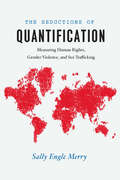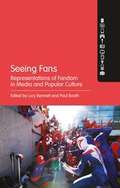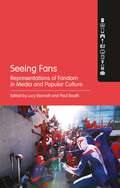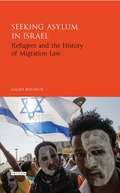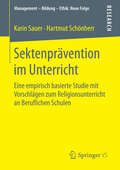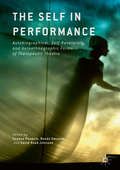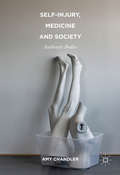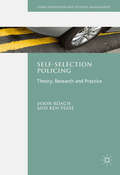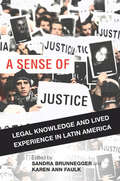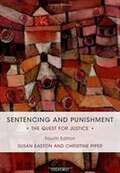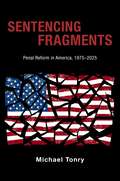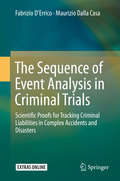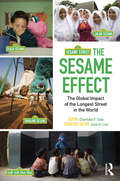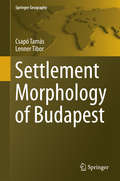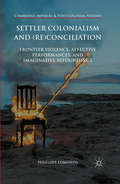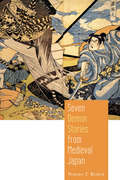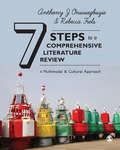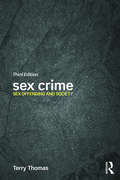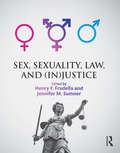- Table View
- List View
The Seductions of Quantification: Measuring Human Rights, Gender Violence, and Sex Trafficking (Chicago Series in Law and Society)
by Sally Engle MerryWe live in a world where seemingly everything can be measured. We rely on indicators to translate social phenomena into simple, quantified terms, which in turn can be used to guide individuals, organizations, and governments in establishing policy. Yet counting things requires finding a way to make them comparable. And in the process of translating the confusion of social life into neat categories, we inevitably strip it of context and meaning—and risk hiding or distorting as much as we reveal. With The Seductions of Quantification, leading legal anthropologist Sally Engle Merry investigates the techniques by which information is gathered and analyzed in the production of global indicators on human rights, gender violence, and sex trafficking. Although such numbers convey an aura of objective truth and scientific validity, Merry argues persuasively that measurement systems constitute a form of power by incorporating theories about social change in their design but rarely explicitly acknowledging them. For instance, the US State Department’s Trafficking in Persons Report, which ranks countries in terms of their compliance with antitrafficking activities, assumes that prosecuting traffickers as criminals is an effective corrective strategy—overlooking cultures where women and children are frequently sold by their own families. As Merry shows, indicators are indeed seductive in their promise of providing concrete knowledge about how the world works, but they are implemented most successfully when paired with context-rich qualitative accounts grounded in local knowledge.
Seeing Fans: Representations Of Fandom In Media And Popular Culture (PDF)
by Lucy Bennett Paul BoothSplit into four sections, Seeing Fans analyzes the representations of fans in the mass media through a diverse range of perspectives. This collection opens with a preface by noted actor and fan Orlando Jones (Sleepy Hollow), whose recent work on fandom (appearing with Henry Jenkins at Comic Con and speaking at the Fan Studies Network symposium) bridges the worlds of academia and the media industry. Section one focuses on the representations of fans in documentaries and news reports and includes an interview with Roger Nygard, director of Trekkies and Trekkies 2. The second section then examines fictional representations of fans through analyses of television and film, featuring interviews with Emily Perkins of Supernatural, Robert Burnett, director of the film Free Enterprise, and Luminosity, a fan who has been interviewed in the New York Magazine for her exemplary work in fandom. Section three explores cultural perspectives on fan representations, and includes an interview with Laurent Malaquais, director of Bronies: The Extremely Unexpected Adult Fans of My Little Pony. Lastly, the final section looks at global perspectives on the ways fans have been represented and finishes with an interview with Jeanie Finlay, director of the music documentary Sound it Out. The collection then closes with an afterword by fan studies scholar Professor Matt Hills.
Seeing Fans: Representations of Fandom in Media and Popular Culture
by Paul Booth Lucy BennettSplit into four sections, Seeing Fans analyzes the representations of fans in the mass media through a diverse range of perspectives. This collection opens with a preface by noted actor and fan Orlando Jones (Sleepy Hollow), whose recent work on fandom (appearing with Henry Jenkins at Comic Con and speaking at the Fan Studies Network symposium) bridges the worlds of academia and the media industry. Section one focuses on the representations of fans in documentaries and news reports and includes an interview with Roger Nygard, director of Trekkies and Trekkies 2. The second section then examines fictional representations of fans through analyses of television and film, featuring interviews with Emily Perkins of Supernatural, Robert Burnett, director of the film Free Enterprise, and Luminosity, a fan who has been interviewed in the New York Magazine for her exemplary work in fandom. Section three explores cultural perspectives on fan representations, and includes an interview with Laurent Malaquais, director of Bronies: The Extremely Unexpected Adult Fans of My Little Pony. Lastly, the final section looks at global perspectives on the ways fans have been represented and finishes with an interview with Jeanie Finlay, director of the music documentary Sound it Out. The collection then closes with an afterword by fan studies scholar Professor Matt Hills.
Seeking Asylum in Israel: Refugees and the History of Migration Law (Library of Modern Middle East Studies)
by Gilad Ben-NunSince 2005, approximately 70,000 asylum-seeking refugees from Sudan and Eritrea have entered Israel. This, along with the highly publicised anti-African immigrant riots in Israel in 2012 and 2014 and the current global refugee crisis, has meant that the issue of African migration has become increasingly controversial. Here Gilad Ben-Nun looks at this phenomenon in its historical and contemporary contexts, and compares it to the wider debates surrounding the Palestinian refugees in the region and the concept of their right of return. He argues that this newer, African migration issue has forced Israel to move from conceiving of itself as an 'exceptional' state and now has to view itself as a more 'normal' and 'universal' entity. Ranging as far back as Israel's important role in the the ratification drafting of the 1951 Refugee Convention and drawing on a variety of methodologies and sources, Ben-Nun offers a wide-ranging legal, social and historical examination of asylum in Israel, that sheds timely light onto themes of migration and identity across the Middle East. This is essential reading for legal historians and lawyers, as well as scholars working on migration studies and the history and politics of the Middle East.
Sektenprävention im Unterricht: Eine empirisch basierte Studie mit Vorschlägen zum Religionsunterricht an Beruflichen Schulen
by Karin Sauer Hartmut SchönherrKarin Sauer und Hartmut Schönherr beleuchten zunächst Hintergründe und Entwicklungen der religiösen Landschaft in der Bundesrepublik. Sie zeigen sowohl religionssoziologische Faktoren als auch entwicklungspsychologische Aspekte auf, die Jugendliche durch „Sekten“ ansprechbar machen können. Im zweiten Teil der Arbeit eröffnen die Autoren unterrichtliche Perspektiven zur Präventionsarbeit im Religionsunterricht an berufsbildenden Schulen. Dabei geht es nicht vorrangig um Krisenintervention, sondern um pädagogische Ansätze und didaktische Handreichungen zur mündigen Auseinandersetzung mit religiösen Angeboten allgemein und im Speziellen mit Angeboten, welche die persönliche und berufliche Entwicklung negativ beeinflussen können.
The Self in Performance: Autobiographical, Self-Revelatory, and Autoethnographic Forms of Therapeutic Theatre
by David Read Johnson Susana Pendzik Renée EmunahThis book is the first to examine the performance of autobiographical material as a theatrical form, a research subject, and a therapeutic method. Contextualizing personal performance within psychological and theatrical paradigms, the book identifies and explores core concepts, such as the function of the director/therapist throughout the creative process, the role of the audience, and the dramaturgy involved in constructing such performances. It thus provides insights into a range of Autobiographic Therapeutic Performance forms, including Self-Revelatory and Autoethnographic Performance. Addressing issues of identity, memory, authenticity, self-reflection, self-indulgence, and embodied self-representation, the book presents, with both breadth and depth, a look at this fascinating field, gathering contributions by notable professionals around the world. Methods and approaches are illustrated with case examples that range from clients in private practice in California, through students in drama therapy training in the UK, to inmates in Lebanese prisons.
The Self in Performance: Autobiographical, Self-Revelatory, and Autoethnographic Forms of Therapeutic Theatre
by Susana Pendzik, Renée Emunah and David Read JohnsonThis book is the first to examine the performance of autobiographical material as a theatrical form, a research subject, and a therapeutic method. Contextualizing personal performance within psychological and theatrical paradigms, the book identifies and explores core concepts, such as the function of the director/therapist throughout the creative process, the role of the audience, and the dramaturgy involved in constructing such performances. It thus provides insights into a range of Autobiographic Therapeutic Performance forms, including Self-Revelatory and Autoethnographic Performance. Addressing issues of identity, memory, authenticity, self-reflection, self-indulgence, and embodied self-representation, the book presents, with both breadth and depth, a look at this fascinating field, gathering contributions by notable professionals around the world. Methods and approaches are illustrated with case examples that range from clients in private practice in California, through students in drama therapy training in the UK, to inmates in Lebanese prisons.
Self-Injury, Medicine and Society: Authentic Bodies
by Amy ChandlerThis book provides an appreciative, sociological engagement with accounts of the embodied practice of self-injury. It shows that in order to understand self-injury, it is necessary to engage with widely circulating narratives about the nature of bodies, including that they are separate from, yet containers of 'emotion'. Using a sociological approach, the book examines what self-injury is, how it functions, and why someone might engage in it. It pays close attention to the corporeal aspects of self-injury, attending to the complex ways in which 'lived experience' is narrated. By interrogating the way in which healthcare and psychiatric systems shape our understanding of self-injury, Self-Injury, Medicine and Society aims to re-invigorate traditional discourse on the subject. Combining analytical theory with real-life accounts, this book provides an engaging study which is both thought-provoking and informative. It will appeal to an interdisciplinary readership and scholars in the fields of medical sociology and health studies in particular.
Self-Selection Policing: Theory, Research and Practice (Crime Prevention and Security Management)
by Ken Pease Jason RoachSelf-Selection Policing introduces and explores an approach for crime control which seeks to identify active, serious offenders by attending to the minor offences they commit. A foundation of theory and evidence is first supplied for the assertion that ‘those who do big bad things also do little bad things’. Original research presented in the book includes a study of offending by visitors to a prison, and the concurrent criminality of those committing common driving offences and failure to produce driving documents as required. It illustrates how self-selection can complement other police methods of identifying active, serious criminals by focusing on what offenders do rather than who they are and what they have done in the past. Concentrating on the ‘usual suspects’ in the conventional way is often criticised as harassment and self-selection policing largely bypasses the issue of fairness this raises. The book concludes with a call for the consideration, development and wider adoption of the self-selection approach, and particularly the identification of other common minor offences which flag concurrent active criminality. The authors make important suggestions for the progression of SSP research and practice, including the identification of barriers to the implementation of the approach in wider police thinking, practice and policy. Practical guidance is also provided for those thinking of developing, testing and implementing the approach. In doing so, the book will be of particular interest for policing practitioners, as well as students and scholars of policing and crime control.
A Sense of Justice: Legal Knowledge and Lived Experience in Latin America
by Sandra Brunnegger and Karen Ann FaulkThroughout Latin America, the idea of "justice" serves as the ultimate goal and rationale for a wide variety of actions and causes. In the Chilean Atacama Desert, residents have undertaken a prolonged struggle for their right to groundwater. Family members of bombing victims in Buenos Aires demand that the state provide justice for the attack. In Colombia, some victims of political violence have turned to the courts for resolution, while others reject the state's ability to fairly adjudicate their grievances and have constructed a non-state tribunal. In each of these examples, the protagonists seek one main thing: justice. A Sense of Justice ethnographically explores the complex dynamics of justice production across Latin America. The chapters examine (in)justice as it is lived and imagined today and what it means for those who claim and regulate its parameters, including the Brazilian police force, the Permanent Peoples' Tribunal in Colombia, and the Argentine Supreme Court. Inextricable as "justice" is from inequality, violence, crime, and corruption, it emerges through memory, in space, and where ideals meet practical limitations. Ultimately, the authors show how understanding the dynamic processes of constructing justice is essential to creating cooperative rather than oppressive forms of law.
Sentencing Fragments: Penal Reform in America, 1975-2025 (Studies in Crime and Public Policy)
by Michael TonryAlmost everyone agrees--Right on Crime, the ACLU, Koch Industries, George Soros's Open Society Foundation, the editorial boards of the New York Times and the Wall Street Journal--that America's current systems for sentencing criminal offenders are a shambles, with crazy quilts of incompatible and conflicting laws, policies, and practices in every state and the federal system. Most everyone agrees that punishments are too severe, and too many people are in prison. However, the kinds of major changes required to undo mass incarceration and rebuild American sentencing are simply not happening. Despite well-intentioned rhetoric and media coverage, there has been very little meaningful change. In Sentencing Fragments, Michael Tonry explains what needs to be done to rebuild just systems of sentencing and punishment, and how to do it. This book tells the story of sentencing policy changes since 1975, examines research findings concerning their effects, and explains what does and does not work. Beyond calling attention to the devastating effects on the lives of the poor and disadvantaged and the latest empirical evidence, Tonry identifies the common moral theories behind criminal sentencing--as well as their larger assumptions about human nature--and discusses the ways in which different theories have bred very different sentencing policies. Sentencing Fragments concludes with a set of proposals for creating better policies and practices for the future, calling for American legislators and politicians to remake sentencing into the humane and just process that it always should have been. In lucid and engaging prose, Michael Tonry reveals the historical foundation for the current state of the American criminal justice system, while simultaneously offering a game plan for long overdue reform.
The Sequence of Event Analysis in Criminal Trials: Scientific Proofs for Tracking Criminal Liabilities in Complex Accidents and Disasters
by Fabrizio D’Errico Maurizio Dalla CasaThis book presents a general method that lawyers, prosecutors and judges can follows to assess the quality and scientific content of technical work done for an accident and crime scene reconstruction. Using multilevel sequence of events analysis allows all key events to be fully identified, which in turn assists judicial bodies in identifying where to assign specific criminal liability. Created from a concept long sought by the two authors (an engineer and an attorney), the method allows readers without any technical background to progress from an examination of evidence gathered at the scene of a complex accident and to reconstruct "beyond reasonable doubt" the events that took place. Once created and scientifically verified by the sequence of events analysis, the chain of key events serves as a reference source for various levels of complex organizations and inter-organization structures in cases involving complex criminal responsibilities.
The Sesame Effect: The Global Impact of the Longest Street in the World
by Charlotte F. Cole June H. LeeThe Sesame Effect details the wide-ranging work of Sesame Workshop and its productions across the world. With an emphasis on impact and evidence from research on projects in low- and middle-income countries, the book tells the stories behind the development of an international family of Muppet characters created for the locally produced adaptations of Sesame Street. Each chapter highlights the educational message of international co-productions and presents the cultural context of each project. Readers will understand the specific needs of children living in a given locale, as well as gain insight into the educational drivers of each project. These projects often deal with difficult issues, from race relations in the United States, to HIV/AIDS education in South Africa, to building respect across cultural divides in the Middle East. Readers will see how local productions have helped build a new mindset that values the importance of early childhood education, and how Sesame Street promotes a brighter future by building children’s academic skills, encouraging healthy habits, and by fostering attitudes that counter negative stereotypes and create appreciation of and respect for others. The Sesame Effect shows how, when magnified across the millions of children touched by the various international programs, Sesame Workshop and its projects are making a difference around the world.
The Sesame Effect: The Global Impact of the Longest Street in the World
by Charlotte F. Cole June H. LeeThe Sesame Effect details the wide-ranging work of Sesame Workshop and its productions across the world. With an emphasis on impact and evidence from research on projects in low- and middle-income countries, the book tells the stories behind the development of an international family of Muppet characters created for the locally produced adaptations of Sesame Street. Each chapter highlights the educational message of international co-productions and presents the cultural context of each project. Readers will understand the specific needs of children living in a given locale, as well as gain insight into the educational drivers of each project. These projects often deal with difficult issues, from race relations in the United States, to HIV/AIDS education in South Africa, to building respect across cultural divides in the Middle East. Readers will see how local productions have helped build a new mindset that values the importance of early childhood education, and how Sesame Street promotes a brighter future by building children’s academic skills, encouraging healthy habits, and by fostering attitudes that counter negative stereotypes and create appreciation of and respect for others. The Sesame Effect shows how, when magnified across the millions of children touched by the various international programs, Sesame Workshop and its projects are making a difference around the world.
Settlement Morphology of Budapest (Springer Geography)
by Csapó Tamás Lenner TiborThis book presents the results of empirical research conducted by the authors, who personally surveyed the people they met on each and every street, square and public space in Budapest. It has four extensive chapters that discuss urban change and structure in Budapest and feature many rich color illustrations. The first chapter looks at the geographical circumstances impacting the city’s urban development in a historical context, as well as the evolution of its functions and demographic processes and the development of the ground plan and settlement structure. The second chapter concerns itself with the way the capital city of Hungary is built, demonstrating the horizontal homogeneity and vertical heterogeneity of development together with development types and locations in Budapest. The third chapter was written about the change in Budapest’s urban structure, especially in regard to the years after 1990. It lists the major factors influencing urban structure transformation, followed by a detailed analysis of Budapest’s functional zones. Lastly, the fourth chapter provides a detailed introduction to each capital city district, including their creation, development and functional structures.
Settler Colonialism and: Frontier Violence, Affective Performances, and Imaginative Refoundings (Cambridge Imperial and Post-Colonial Studies Series)
by Penelope EdmondsThis book examines the performative life reconciliation and its discontents in settler societies. It explores the refoundings of the settler state and reimaginings of its alternatives, as well as the way the past is mobilized and reworked in the name of social transformation within a new global paradigm of reconciliation and the 'age of apology'.
Seven Demon Stories from Medieval Japan
by Noriko T. ReiderIn Japanese culture, oni are ubiquitous supernatural creatures who play important roles in literature, lore, and folk belief. Characteristically ambiguous, they have been great and small, mischievous and dangerous, and ugly and beautiful over their long history. Here, author Noriko Reider presents seven oni stories from medieval Japan in full and translated for an English-speaking audience. Reider, concordant with many scholars of Japanese cultural studies, argues that to study oni is to study humanity. These tales are from an era in which many new oni stories appeared for the purpose of both entertainment and moral/religious edification and for which oni were particularly important, as they were perceived to be living entities. They reflect not only the worldview of medieval Japan but also themes that inform twenty-first-century Japanese pop and vernacular culture, including literature, manga, film, and anime. With each translation, Reider includes an introductory essay exploring the historical and cultural importance of the characters and oni manifestations within this period. Offering new insights into and interpretations of not only the stories therein but also the entire genre of Japanese ghost stories, Seven Demon Stories is a valuable companion to Reider’s 2010 volume Japanese Demon Lore. It will be of significant value to folklore scholars as well as students of Japanese culture.
The Seven Pillars of Statistical Wisdom
by Stephen M. StiglerWhat gives statistics its unity as a science? Stephen Stigler sets forth the seven foundational ideas of statistics—a scientific discipline related to but distinct from mathematics and computer science and one which often seems counterintuitive. His original account will fascinate the interested layperson and engage the professional statistician.
Seven Steps to a Comprehensive Literature Review: A Multimodal and Cultural Approach
by Anthony J. Onwuegbuzie Rebecca FrelsLecturers/instructors - request a free digital inspection copy here This dynamic guide to doing literature reviews demystifies the process in seven steps to show researchers how to produce a comprehensive literature review. Teaching techniques to bring systematic thoroughness and reflexivity to research, the authors show how to achieve a rich, ethical and reflexive review. What makes this book unique: Focuses on multimodal texts and settings such as observations, documents, social media, experts in the field and secondary data so that your review covers the full research environment Puts mixed methods at the centre of the process Shows you how to synthesize information thematically, rather than merely summarize the existing literature and findings Brings culture into the process to help you address bias and understand the role of knowledge interpretation, guiding you through Teaches the CORE of the literature review – Critical thinking, Organization, Reflections and Evaluation – and provides a guide for reflexivity at the end of each of the seven steps Visualizes the steps with roadmaps so you can track progress and self-evaluate as you learn the steps This book is the essential best practices guide for students and researchers, providing the understanding and tools to approach both the ‘how’ and ‘why’ of a rigorous, comprehensive, literature review.
Seven Steps to a Comprehensive Literature Review: A Multimodal and Cultural Approach (PDF)
by Anthony J. Onwuegbuzie Rebecca FrelsLecturers/instructors - request a free digital inspection copy here This dynamic guide to doing literature reviews demystifies the process in seven steps to show researchers how to produce a comprehensive literature review. Teaching techniques to bring systematic thoroughness and reflexivity to research, the authors show how to achieve a rich, ethical and reflexive review. What makes this book unique: Focuses on multimodal texts and settings such as observations, documents, social media, experts in the field and secondary data so that your review covers the full research environment Puts mixed methods at the centre of the process Shows you how to synthesize information thematically, rather than merely summarize the existing literature and findings Brings culture into the process to help you address bias and understand the role of knowledge interpretation, guiding you through Teaches the CORE of the literature review – Critical thinking, Organization, Reflections and Evaluation – and provides a guide for reflexivity at the end of each of the seven steps Visualizes the steps with roadmaps so you can track progress and self-evaluate as you learn the steps This book is the essential best practices guide for students and researchers, providing the understanding and tools to approach both the ‘how’ and ‘why’ of a rigorous, comprehensive, literature review.
Sex Crime: Sex offending and society
by Terry ThomasSex Crime, Third edition offers a comprehensive and integrative introduction to sex crime, written by an expert in the field. The third edition has been fully expanded and updated to include further coverage of a range of critical topics, including child sexual exploitation, child pornography, female sex offenders, treatment approaches such as the ‘Good Lives Model’ and the European Convention on Human Rights. Delving into and beyond the news headlines about sexual crimes that seem to appear on our screens and in our newspapers almost every day, this third edition draws on a range of high profile case studies, such as Vanessa George, Stuart Hall, Jimmy Savile and Operation Yewtree and also offers a review of all relevant legislation. This new edition also includes an analysis of possible causes of sex offending, as well as public and professional responses to sex crime. Including an examination of the policing of sexual crime; the prosecution of the accused; the sentencing and punishment of sexual offenders; and ‘public protection’ measures, this new edition covers all of the key aspects of sex crime and how it is dealt with. Wide-ranging and authoritative, Sex Crime, Third edition presents a complex area in a straightforward and understandable manner. Thomas guides the reader through the range of policies and law which have accumulated over the years, making this essential reading for academics and students engaged in the study of sex crime, sexual violence and the treatment of sex offenders. It will also be of great interest to criminal justice practitioners.
Sex Crime: Sex offending and society
by Terry ThomasSex Crime, Third edition offers a comprehensive and integrative introduction to sex crime, written by an expert in the field. The third edition has been fully expanded and updated to include further coverage of a range of critical topics, including child sexual exploitation, child pornography, female sex offenders, treatment approaches such as the ‘Good Lives Model’ and the European Convention on Human Rights. Delving into and beyond the news headlines about sexual crimes that seem to appear on our screens and in our newspapers almost every day, this third edition draws on a range of high profile case studies, such as Vanessa George, Stuart Hall, Jimmy Savile and Operation Yewtree and also offers a review of all relevant legislation. This new edition also includes an analysis of possible causes of sex offending, as well as public and professional responses to sex crime. Including an examination of the policing of sexual crime; the prosecution of the accused; the sentencing and punishment of sexual offenders; and ‘public protection’ measures, this new edition covers all of the key aspects of sex crime and how it is dealt with. Wide-ranging and authoritative, Sex Crime, Third edition presents a complex area in a straightforward and understandable manner. Thomas guides the reader through the range of policies and law which have accumulated over the years, making this essential reading for academics and students engaged in the study of sex crime, sexual violence and the treatment of sex offenders. It will also be of great interest to criminal justice practitioners.
Sex, Sexuality, Law, and (In)justice
by Henry F. Fradella Jennifer M. SumnerSex, Sexuality, Law, and (In)Justice covers a wide range of legal issues associated with sexuality, gender, reproduction, and identity. These are critical and sensitive issues that law enforcement and other criminal justice professionals need to understand. The book synthesizes the literature across a wide breadth of perspectives, exposing students to law, psychology, criminal justice, sociology, philosophy, history, and, where relevant, biology, to critically examine the social control of sex, gender, and sexuality across history.? Specific federal and state case law and statutes are integrated throughout the book, but the text moves beyond the intersection between law and sexuality to focus just as much on social science as it does on law.? This book will be useful in teaching courses in a range of disciplines—especially criminology and criminal justice, history, political science, sociology, women and gender studies, and law.
Sex, Sexuality, Law, and (In)justice
by Henry F. Fradella Jennifer M. SumnerSex, Sexuality, Law, and (In)Justice covers a wide range of legal issues associated with sexuality, gender, reproduction, and identity. These are critical and sensitive issues that law enforcement and other criminal justice professionals need to understand. The book synthesizes the literature across a wide breadth of perspectives, exposing students to law, psychology, criminal justice, sociology, philosophy, history, and, where relevant, biology, to critically examine the social control of sex, gender, and sexuality across history.? Specific federal and state case law and statutes are integrated throughout the book, but the text moves beyond the intersection between law and sexuality to focus just as much on social science as it does on law.? This book will be useful in teaching courses in a range of disciplines—especially criminology and criminal justice, history, political science, sociology, women and gender studies, and law.
